Nikolay Stoimenov
Bulgarian Academy of Sciences, IICT, Bulgaria
Gabriela Kotseva
Bulgarian Academy of Sciences, IICT, Bulgaria
Vanya Georgieva
Technical University of Sofia, Bulgaria
https://doi.org/10.53656/adpe-2025.04
Pages 40-53
Abstract. This article aims to classify the different types of 3D printers and their technologies, providing an overview of the opportunities and challenges associated with additive manufacturing. This classification aims to help understand the variety of solutions and technologies available on the market and their applications in various fields such as industry, science, education, society and others.
Keywords: 3D printers; technologies; additive manufacturing
- Introduction
The technology of 3D printing, also known as additive manufacturing, is gaining widespread attention and significant interest. It has quickly established itself as a revolutionary technology that is transforming manufacturing processes across numerous industries, supporting scientific research, and contributing to rapid prototype testing. This innovative technology boasts a remarkably long and rich history. The popular method ranks among the fastest and most accessible technological processes for creating consumer goods, medical supplies, and products for diverse industrial manufacturing3 (Han et al., 2025; Piedra-Cascón et al., 2021; Graça et al., 2024).
Additive manufacturing (AM) is a method that differs from conventional manufacturing processes such as milling and cutting by producing final products through the melting of materials at high temperatures and their deposition to create a three-dimensional object from a digital model (Han et al., 2025). The technology eliminates the need for traditional manufacturing tools and allows for the realization of complex geometric structures that would be impossible or economically unfeasible with conventional methods (Han et al., 2025; Piedra-Cascón et al., 2021; ASTM/ISO, 2015, p. 5; Siddique et al., 2022).
This process drastically reduces waste, lowers production costs, and enables more efficient and personalized manufacturing. As businesses increasingly focus on sustainability and cost reduction, 3D printing represents a viable solution to these challenges (Graça et al., 2024).
The primary objective of this article is to present a classification of the various types of 3D printers and their technologies. To illustrate this, research findings related to industry, history, arts, science, and education are presented.
- Classification of 3D printers according to printing technology
Each of the existing 3D printing technologies today has its advantages and disadvantages. The types of additive manufacturing can be categorized based on what they produce or based on the type of material they use. In order to apply a structure to the technology on a global scale, the International Organization for Standardization (ISO) divides them into seven general types, as shown in Table 1.
Table 1 outline the seven general types of additive manufacturing technologies as classified by the International Organization for Standardization (ISO, 2015.).
These types include:
2.1. Material Extrusion – Material extrusion (ME) is a widely utilized additive manufacturing process that entails the continuous dispensing of material through a heated nozzle. This material is deposited along a predetermined path in a layer-by-layer fashion to construct a 3D object. Key factors influencing the mechanical characteristics of the printed parts include layer thickness, filament width, and the orientation of the layers (Siddique et al., 2022).
2.2. Vat Polymerization – Compared with other 3D printing technologies, vat photopolymerization can print structures with higher resolution and more complexity. The most common forms of vat polymerization are mainly three types of technologies: stereolithography (SLA), digital light processing (DLP), and liquid crystal display (LCD), also known as masked stereolithography (MSLA) (Lee et al., 2001).
2.3. Material Jetting -Material jetting 3D-printing is also known as PolyJet (Dikovsky & Shtilerman, 2018) or MultiJet Modeling (Leyden et al., 2018). This technology allows different materials to be printed in the same object. One application of this technique is the production of parts in multiple colors and textures. The process of material jetting enables the printing of various materials within a single object. One application of this technique is the creation of components featuring multiple colors and textures. (Hayes et al., 2022).
2.4. Powder Bed Fusion – The Powder Bed Fusion (PBF) process includes popular techniques like Direct Metal Laser Sintering (DMLS), Electron Beam Melting (EBM), Selective Heat Sintering (SHS), Selective Laser Melting (SLM), and Selective Laser Sintering (SLS). PBF methods use lasers or electron beams to melt and bond powder materials. EBM operates in a vacuum and is ideal for metals and alloys, producing functional parts. In PBF, fresh powder is layered over existing layers using mechanisms like rollers or blades, with a hopper supplying the material. DMLS is similar to SLS but focuses on metals, while SHS uses a heated print head for bonding with a roller for layer application. The build platform lowers as the model height increases.
2.5. Directed Energy Deposition – Directed Energy Deposition (DED) is a manufacturing process that melts materials, primarily metals like titanium and aluminum, using a focused energy source. The molten material, in powder or wire form, is deposited by a nozzle onto a surface. DED is often used for repairs or enhancing existing parts, and when combined with CNC machining, it achieves high precision. However, it has limitations, including the need for inert gas, post-processing for surface quality, and material waste, which can impact efficiency (Zahidin et al., 2023).
2.6. Binder Jetting – Binder jetting is a 3D printing technology that selectively deposits a liquid binder onto a powder bed to build parts layer by layer. It differs from other methods and is popular for its unique benefits. The process typically involves powder spraying, cutting print head nozzles, and drying or partially curing the binder (Zheng et al., 2024).
A spread roller compacts the powder at low pressure, creating voids and reducing contact between particles, leading to high porosity in the final product after sintering (Choi et al., 2025a). Key parameters include powder flowability, compatibility with the binder, and binder bonding (Jadhav et al., 2025).
2.7. Sheet Lamination – This 3D printing technology builds structures by stacking sheets of closed fibers that are laminated with a laser or adhesive. This method has been shown to significantly improve the mechanical properties of rigid polymers such as plastic and resin. Technology has struggled to fabricate complex internal structures due to the difficulty of removing unwanted material (Choi et al., 2025b).
Table 1. Classification of 3D print technologies
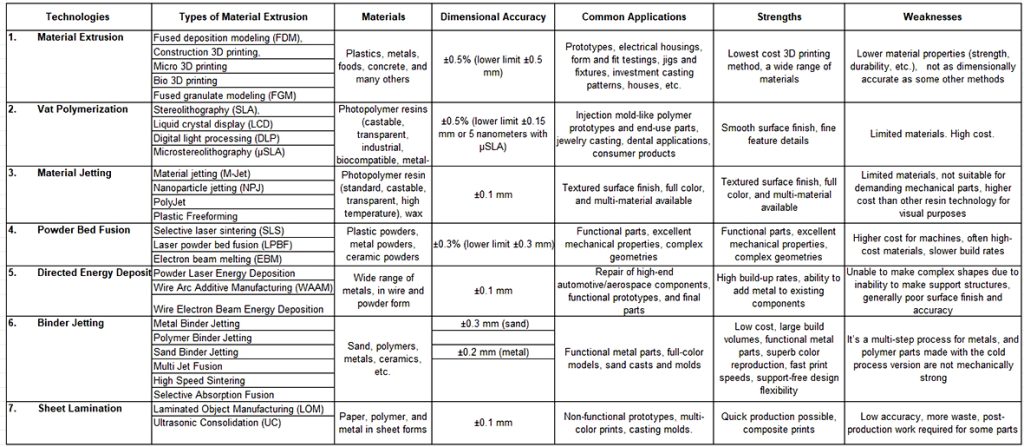
- Applications of 3D technologies
The 3D printing revolution has opened up a wide range of industries, enabling the creation of complex shapes, reducing material waste and producing highly efficient structures. Today, there are already numerous application areas in industry, with 3D technologies being used to create prototypes, tools and even finished products. For example, in the automotive sector, companies such as General Motors use 3D printing technology to produce complex components that help reduce development time (McKeogh, 2025). This technology is also applied in aerospace for lightweight components, automotive manufacturing, bioprinting, in fashion for custom designs, consumer technology, dentistry, foundries, jewelry, medicine, motorsports, semiconductors, service bureaus, as well as in trucks, buses, rail transport, and turbomachinery.
In civil construction, 3D-printed formwork for concrete allows for intricate and lightweight designs, making it essential to study its sustainability to promote low-carbon practices (Sangiorgio et al., 2025). In the medical field, 3D printing and hydrogel-based inks enhance precision medicine, aiding diagnostics and treatment by creating structures that mimic natural tissues. Key advancements include real-time detection, drug delivery, and regenerative medicine. This technology also improves molecular diagnostics and wearable biosensors for health monitoring and has transformed wound care by enabling advanced dressings that optimize healing through customized scaffolds with enhanced antibacterial properties (Wu et al., 2025). Beyond these fields, 3D printing is increasingly applied in science, education, specialized training of disadvantaged people, as well as in the socialization of these people in society.
The high level of customization and precision of 3D printing allows scientists to create unique prototypes for scientific research. For example, researchers can print specific models for tests. In educational settings, 3D printing is entering the classroom, allowing students to visualize concepts and engage with practical applications. This approach is increasing interest in STEM (science, technology, engineering, and mathematics) subjects. These devices offer teachers and students the opportunity to create real objects from virtual models, stimulating creativity and practical skills. Whether it is prototyping, teaching aids or artistic works, 3D technologies are a useful part of education (Sen et al., 2021).
Additive manufacturing offers significant opportunities to improve science and education for the blind and visually impaired and can be used in a variety of ways. 3D technologies are already being used to create tactile learning materials that help blind students understand complex concepts in subjects such as math, science, geography, and other subjects.
Tactile geographic models can represent topography, city plans, or historical sites, while biological models can include anatomical structures such as the human skeleton, models of cell structures.
3D printing technologies allow the production of educational tools and materials that meet the individual needs of students with special needs, such as braille signs for marking different rooms /laboratories, classrooms, etc./, tactile books and textbooks enriched with 3D printed elements that include braille and tactile images. Personalized tools, such as tactile geometric shapes, can be useful in teaching mathematical concepts, such as those illustrated in Fig.1.
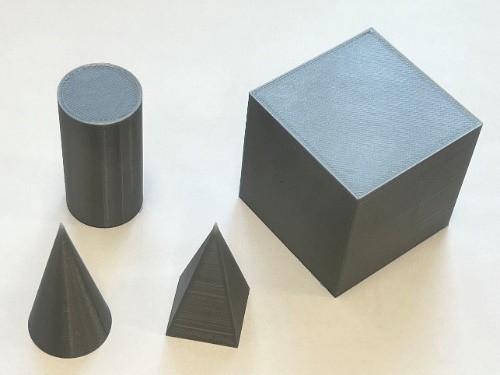
Figure 1. Three-dimensional models for visually impaired people
3D printing can also be used to create assistive devices that improve accessibility, such as adaptive navigation technologies, including cane holders or smartphone mounts that offer feedback. Additionally, customized tools, such as ergonomic tool handles and writing aids, can be designed based on the needs of users.
In the scientific field, 3D printing is a valuable research tool, allowing researchers to create prototypes of assistive devices or tools to test 3D printing materials, study their effectiveness, and modify existing tools to improve usability for visually impaired students.
3D printing projects can raise awareness of the capabilities and needs of the blind. For example, demonstrations through exhibitions of 3D printed educational materials, as shown in Fig.2, can highlight the importance of accessibility in education and encourage further development in this field.
Participation in community projects can increase interest and support initiatives aimed at improving the educational experience for blind students.
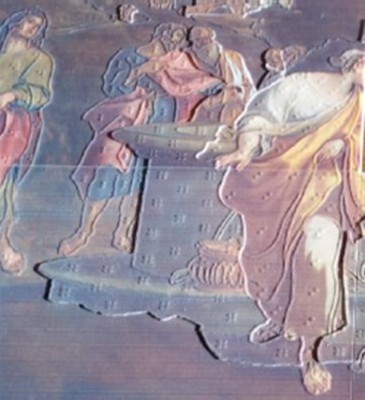
Figure 2. Tactile tile for Brera Gallery
- Additive manufacturing capabilities
One of the above-mentioned significant applications of additive technologies, namely in improving the quality of life of blind people, is currently undergoing a number of studies. 3D technologies make it possible to conduct research in the field of 3D printed materials and their application for the blind from a tribological point of view. Tribological analyses are carried out for the wear resistance of 3D printed Braille inscriptions, using the printers listed in Table 2, working with different 3D printing technologies, with different dimensions and materials.
Fused Deposition Modeling (FDM) or Fused Filament Fabrication (FFF) (Hosseinzadeh et al., 2025) is a printing method that belongs to the material extrusion technology, as it melts and extrudes thermoplastic filaments, which the printer nozzle deposits layer by layer in the build area.
In this popular technology for manufacturing 3D objects, it is crucial to choose the right printing parameters to improve production efficiency, reduce costs and purposefully control the performance of printed products (Ahmad et al., 2024). The TEVO Tornado 3D printer, the UltiMaker S5 3D printer and the Bambu Lab 3D printer work with this printing technology. PolyJet 3D printing is known for its exceptional resolution and precision, as well as its ability to work with a variety of materials.
This technology belongs to the Material Jetting category of 3D printing and has been on the market since 2005. PolyJet allows for the combination of different material properties, including colors and hardness, in a single part. This method offers a cost-effective solution for prototyping elastomeric and complex structures, as it does not require tooling. As with other 3D printing methods, it builds parts layer by layer, starting from a base. PolyJet uses a print head with multiple jets that spray tiny droplets of liquid photopolymer with a diameter of 42 microns, forming layers as thin as 30 microns (Sanders et al., 2022).
These layers are then quickly cured under the influence of ultraviolet light. The support material is printed at the same time, allowing parts produced with PolyJet to be self-supporting. Once the build is complete, the part undergoes a quick treatment in a chemical solution that dissolves the supports and leaves surfaces that are smooth and precise. The Stratasys Objet260 Connex3 works on exactly this principle.
Table 2. Clasification of used 3D print technologies
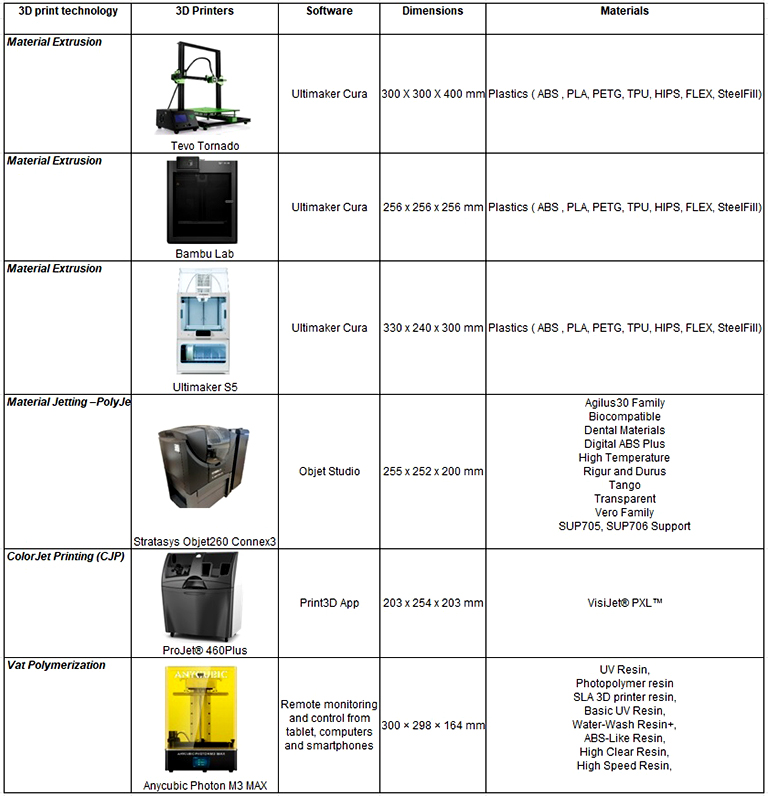
The ProJet® 460Plus2 is a professional 3D printer that uses ColorJet printing technology. The ProJet CJP color 3D printer technology works with advanced features 3-channel CMY full-color 3D printing. The ProJet CJP 460Plus1 can create beautiful, photorealistic components in CMY colors, with the ability to fully texturize and UV map, allowing for a better evaluation of the appearance and style of products, without the need for painting4, as in the photo in Fig. 3.
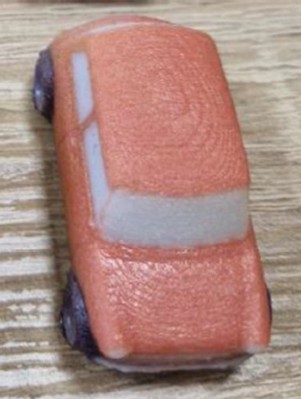
Figure 3. Car – 3D printed with ProJet® 460Plus
Anycubic Photon M3 MAX works on the principle of Vat Polymerization 3D printing technology. It produces smooth details and the interaction of the technology with the perceptions of visually impaired people is still being studied. On Figure 4. A) a Braille signboard produced by Anycubic Photon M3 MAX is depicted, and B) a Braille signboard produced by Stratasys Objet260 Connex3, made with Polyjet technology.
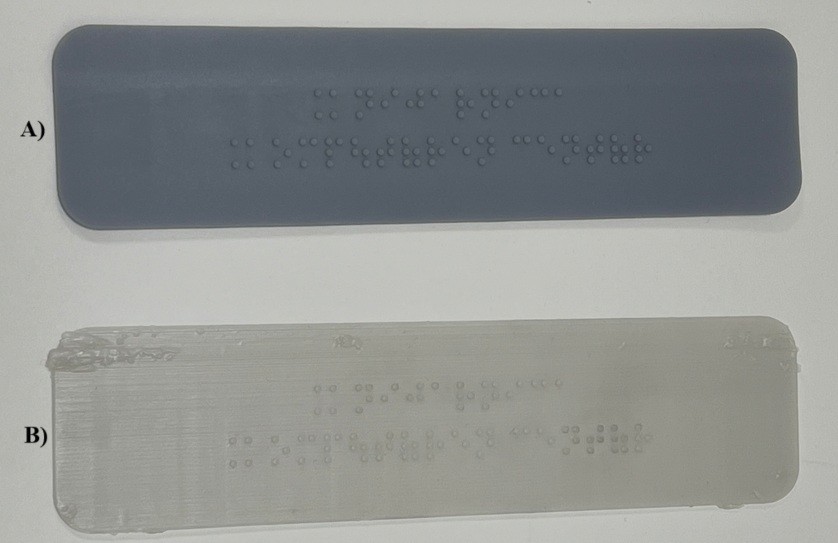
Figure 4. Braille signboard produced by A) Anycubic Photon M3 MAX and B) Stratasys Objet260 Connex3
Technologies enable rapid modeling and prototyping of Braille with different variations of dots illuminating words and symbols, which allows for in-depth research into the most appropriate sizes and shapes, and the most appropriate adaptations to the tactile sensation of individual readers.
A similar study was conducted with part of the team in 2024 on 3 variants of 3D printing depending on the characteristics of the print and the surface layer (rounded and unrounded). The study found that signs with rounded braille dots were more pleasant to read, as the hand easily followed the line. Reading was closest to reading Braille written on standard paper. It is reported that the material used VeroWhite 1 (Fig. 1 b) white transparent plates)) is very pleasant to the touch and looks durable. This study proved that the capabilities of 3D technologies in this area are extremely significant and necessary for visually impaired people (Tzvetkova-Arsova et al., 2024). Photos from the experiment are attached in Fig. 5.
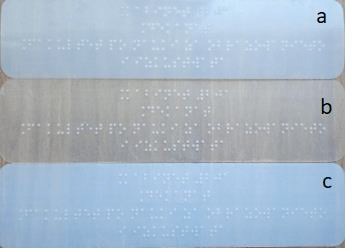
Figure 5. Braille plates – VeroWhite Material 1 a) rounded with glossy finish, b) rounded without glossy finish, c) cone without glossy finish
3D technologies today offer many opportunities, but they also face a number of significant challenges. The main challenges are:
- a) Material limitations: The availability of materials for 3D printing is still limited compared to traditional manufacturing. The lack of variety in materials restricts applications and the quality of the produced parts.
- b) Quality issues: Achieving a high degree of repeatability and quality in printed objects remains a challenge. Printing processes can be sensitive to various factors, including temperature and humidity, which can lead to defects.
- c) Legal and ethical aspects: In the context of 3D printing, legal and ethical questions are often raised. Some of these include the production of weapons or replicas of protected objects.
- d) Impact on supply chains: The proliferation of 3D printing may change the way supply chains operate, affecting the demand for traditional manufacturers and the structure of goods concerning speed and delivery.
- Future Steps
With the rapid development of 3D printing technologies, the future of the industry looks very promising. Fierce competition and innovation will not only expand the classification of 3D printing, help reduce the cost, increase the accessibility of this technology, and lead to new applications and methods.
Key areas that can move forward are: possible expansion of the ISO classification, the introduction of new materials, intelligent algorithms and machine learning, Automation of 3D printing preparation processes and product finalization, Mass customization, Entry into new industries, Development of sustainable and environmentally friendly production processes, Creation of tactile books that include textures, graphics and patterns that the blind can “experience” through touch, Navigational aids for people with disabilities, etc.
Conclusion
3D printing represents one of the most exciting technological advances of our time. With its advantages, including customization, fast development time, cost-effectiveness and innovation, it provides unique solutions for various industries.
All ISO-classified 3D printing technologies have their own advantages and disadvantages, which determine in which industries and for what purposes they are used. The choice of technology often depends on factors such as material requirements, desired properties of the final products, production speed and costs.
New technologies and approaches that can increase efficiency, safety and quality of life, using 3D printing, by improving its impact on production chains and social innovation, have great potential for development.
Acknowledgments
The research was carried out as part of the project No KP-06-H85/11 “Exploring 3D technologies to support the learning process and lives of the visually impaired”, financed by the Bulgarian National Science Fund.
NOTES
- Projet CJP 460Plus. https://www.3d-me.com/projet-cjp-460plus.
- ProJet® 460Plus – Professional 3D Printer. https://iict.bas.bg/acomin/smart_lab/3D_Printer.pdf.
- The Role of 3D Printing in Reducing Manufacturing Costs and Waste. https://tavtechsolutions.com/resources/whitepapers/the-role-of-3d-printing-in-reducing-manufacturing-costs-and-waste/.
- 3D Systems 460Plus 3D Printer. https://advantage3d.com/projet-460plus-3d-printer.
REFERENCES
Ahmad, M., Javaid, M. & Haleem, A. (2024). A study on fused deposition modeling (FDM) and laser-based additive manufacturing (LBAM) in the medical field. Intelligent Pharmacy, 2(3), 381 – 391. https://doi.org/10.1016/j.ipha.2024.02.010.
ASTM International. (2015). Standard terminology for additive manufacturing – general principles – terminology (ISO/ASTM 52900:2015).
Choi, J.-H., Kwon, M., Hwang, K.-T., Kim, J.-H., Choi, J.-H., Kim, U.-S. & Han, K.-S. (2025a). Mechanical reinforcement of complex shaped ceramic filter fabricated using binder jetting process with photocurable composite ink. Journal of Materials Research and Technology, 35, 5514 – 5520. https://doi.org/10.1016/j.jmrt.2025.02.115.
Choi, J., Sung, K., Hyun, J. & Shin, S. (2025b). Sheet-laminated additive manufacturing of bacterial cellulose nanofiber-reinforced hydrogels. Carbohydrate Polymers, Part B, 349, 122972. https://doi.org/10.1016/j.carbpol.2024.122972.
Dikovsky, D. & Shtilerman, S. (2018). System and method for fabricating a body part model using multi-material additive manufacturing. (US Patent US9999509B2). United States. https://patents.google.com/patent/US9999509B2/en.
Graça, A., Bom, S., Martins, A.M., Ribeiro, H.M. & Marto, J. (2024). Vat-based photopolymerization 3D printing: From materials to topical and transdermal applications. Asian Journal of Pharmaceutical Sciences, 19(4), 100940. https://doi.org/10.1016/j.ajps.2024.100940.
Han, J., Jo, H., Song, Y., Ga, D., Shin, J.H. & Song, J.-H. (2025). Fused powder extrusion 3D printing process for reduced-cost, simple operation, and wide material selection. Journal of Manufacturing Processes, 140, 53 – 62. https://doi.org/10.1016/j.jmapro.2025.02.034.
Hayes, B., Hainsworth, T. & MacCurdy, R. (2022). Liquid–solid co-printing of multi-material 3D fluidic devices via material jetting. Additive Manufacturing, 55, 102785. https://doi.org/10.1016/j.addma.2022.102785.
Hosseinzadeh, M.H., Azarniya, A., Hassanpour, M., Borhan Panah, M.R., Hajitabar, A., Abbasi Bafetrat, H. & Sadegh Yazdi, M. (2025). Beyond standard ABS: Recent advances in modified and composite filaments prepared for fused deposition modeling. Heliyon, 11(8), e43051. https://doi.org/10.1016/j.heliyon.2025.e43051.
ISO. (2015). Additive manufacturing general principles: Part 2 Overview of process categories and feedstock (ISO 17296-2:2015). https://www.iso.org/standard/61626.html?browse=tc.
Jadhav, Y., Bhingoli, O., Mali, A., Pawar, V. & Shinde, V. (2025). Leveraging 3D printing for advanced wound dressing technologies by using polymeric materials and polymeric biomaterials. Hybrid Advances, 8, 100364. https://doi.org/10.1016/j.hybadv.2024.100364.
Lee, S.H., Park, W.S., Cho, H.S., Zhang, W. & Leu, M.C. (2001). A neural network approach to the modelling and analysis of stereolithography processes. Proceedings of the Institution of Mechanical Engineers, Part B: Journal of Engineering Manufacture, 215(12), 1719 – 1733. https://doi.org/10.1177/095440540121501206.
Leyden, R.N., Thayer, J.S., Bedal, B.J.L., Almquist, T.A., Hull, C.W. & Earl, J. M. Kerekes, T. A., Smalley, D. R., Merot, C. M., Fedchenko, R. P., Lockard, M. S., Pang, T. H., That, D. T. (2018). Selective deposition modeling method and apparatus for forming three-dimensional objects and supports. (US Patent US6193923B1). United States. https://patents.google.com/patent/US6193923B1/en.
McKeogh, J. (2025, January 15). GM’s additive manufacturing brings 3D printed innovation to products and plants. General Motors. https://news.gm.com/home.detail.html/Pages/topic/us/en/2025/jan/0115-additive.html#:~:text=GM’s%20additive%20manufacturing%20brings%203D%20printed%20innovation%20to%20products%20and%20plants&text=Teams%20across%20General%20Motors%20are,from%20pre%2Dproduction%20to%20motorsports.
Piedra-Cascón, W., Krishnamurthy, V.R., Att, W. & Revilla-León, M. (2021). 3D printing parameters, supporting structures, slicing, and post-processing procedures of vat-polymerization additive manufacturing technologies: A narrative review. Journal of Dentistry, 109, 103630. https://doi.org/10.1016/j.jdent.2021.103630.
Sanders, J., Wei, X. & Pei, Z. (2022). Experimental Investigation of PolyJet 3D printing: Effects of Sample Location and Volume on Power Consumption. Manufacturing Letters, 31, 83 – 86. https://doi.org/10.1016/j.mfglet.2021.07.013.
Sangiorgio, V., Bianchi, I. & Forcellese, A. (2025). Advancing decarbonization through 3D printed concrete formworks: Life cycle analysis of technologies, materials, and processes. Energy and Buildings, 332, 115444. https://doi.org/10.1016/j.enbuild.2025.115444.
Sen, C., Ay, Z.S. & Kiray, S.A. (2021). Computational thinking skills of gifted and talented students in integrated STEM activities based on the engineering design process: The case of robotics and 3D robot modeling. Thinking Skills and Creativity, 42, 100931. https://doi.org/10.1016/j.tsc.2021.100931.
Siddique, S.H., Hazell, P.J., Wang, H., Escobedo, J.P. & Ameri, A.A.H. (2022). Lessons from nature: 3D printed bio-inspired porous structures for impact energy absorption – A review. Additive Manufacturing, 58, 103051. https://doi.org/10.1016/j.addma.2022.103051.
Tzvetkova-Arsova, M., Tomova, M., Stoimenov, N., Kotseva, G., Chivarov, N., Nikolova, D.S. & Lozanova, S. (2024). Accessibility of Braille Texts for the Visually Impaired Produced with Different 3D Printing Technologies. IFAC-PapersOnLine, 58(3), 50 – 54. https://doi.org/10.1016/j.ifacol.2024.07.123.
Wu, H., Diao, J., Li, X., Yue, D., He, G., Jiang, X. & Li, P. (2025). Hydrogel-based 3D printing technology: From interfacial engineering to precision medicine. Advances in Colloid and Interface Science, 341, 103481. https://doi.org/10.1016/j.cis.2025.103481.
Zahidin, M.R., Yusof, F., Abdul Rashid, S.H., Mansor, S., Raja, S., Jamaludin, M.F., Manurung, Y.H.P., Adenan, M.S. & Hussein, N.I.S. (2023). Research challenges, quality control and monitoring strategy for Wire Arc Additive Manufacturing. Journal of Materials Research and Technology, 24, 2769 – 2794. https://doi.org/10.1016/j.jmrt.2023.03.200.
Zheng, C., Bhandari, B., MV, S., Mandal, D., Bracken, C., Pierce, A. & Ohodnicki, P. (2024). Binder jet 3D printing of Mn–Zn ferrite soft magnet toroidal cores. Applied Materials Today, 41, 102475. https://doi.org/10.1016/j.apmt.2024.102475.
Prof. Nikolay Stoimenov, PhD
ORCID iD: 0000-0001-5171-9830
Web of Science Researcher ID: J-9434-2019
Bulgarian Academy of Sciences,
Institute of Information and Communication Technologies
Sofia, Bulgaria
E-mail: nikolay.stoimenov@iict.bas.bg
Assis. Prof. Gabriela Kotseva
ORCID iD: 0009-0000-7099-0052
Web of Science Researcher ID: HLS-6821-2023
Bulgarian Academy of Sciences, IICT
Institute of Information and Communication Technologies
Sofia, Bulgaria
E-mail: gabriela.kotseva@iict.bas.bg
Assoc. Prof. Vanya Georgieva, PhD
ORCID iD: 0009-0008-2025-8144
Technical University of Sofia
Sofia, Bulgaria
E-mail: vgeorgieva@tu-sofia.bg




